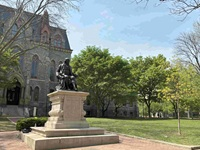Speaker
Description
In pursuit of a quantum computer, there have been many proposals of qubits that take advantage of quantum systems, from solid-state systems to trapped ions. A particularly promising candidate is the transmon, a qubit based on a superconducting resonator with a Josephson Junction and optimized to have reduced sensitivity to charge noise. It is well-known that these types of qubits suffer from decoherence via quasiparticle poisoning sources that originate from, e.g., environmental radioactivity, interfacial solid-state physics, and more. Importantly, some sources (such as environmental radioactivity) can induce correlated errors among multiple qubits, which can be catastrophic for error-correction schemes in quantum computers.
At PNNL, we are investigating the contribution of cosmogenic radiation to qubit errors. To do so, we utilize microwave kinetic inductance detectors [MKIDs]. Like transmon qubits, MKIDs consist of a superconducting resonator patterned onto a substrate (often silicon or sapphire), but with the added benefit of spectroscopic capabilities. With MKIDS, we measure the background spectra a qubit would see, from both our shallow underground lab and from the surface. Our Low Background Cryogenic Facility is located underground with a ~30-meter water-equivalent overburden, which suppresses the cosmogenic muon flux suppressed by a factor of ~6 and the cosmogenic proton and neutron fluxes by a factor of >100. We hypothesize that the residual catastrophic correlated error rate observed in gap-engineered qubits is due to high energy interactions with cosmic-ray-produced neutrons and protons. By comparing spectra acquired in our surface and shallow underground labs, we test the effectiveness of a shallow overburden to attenuate the highest energy events.

